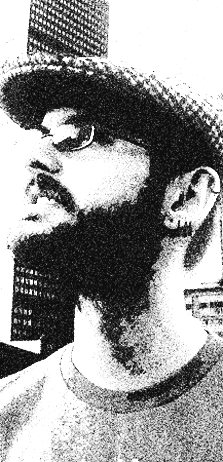Mano a Mano
Mano a Mano is a regulation-size arm-wrestling table built on massive legs. However, it is not a regular arm-wresting table. The rusty steel top, worn leather elbow rests, and sweat-stained pin pads, and walnut enclosure conceal electronics that sense and process the wrestling match. Players discover that the table reacts to the back-and-forth movement of their interlocked grip. The table detects hand and arm location as players exert force and press for victory, and the table responds by playing pre-recorded sounds.
Arm wrestling stirs images of muscles and gambling: power and greed on a man-to-man scale; one-on-one competition across and around a back-room table. The design of the table evokes but also extends the image. The massive, square design recalls the imposing shape of a fortress with corner towers. Players become soldiers who look one another in the eye and, while they compete, hear the voice of an unseen person: a drill sergeant barking orders. The voice, however, is female. She calls out passersby, outlines rules, starts the contest, chides those who cheat, and berates underachievers. The table borrows an image from the battlefield and a voice from boot camp.
Mano a Mano is a metaphor. Soldiers engage in hand-to-hand combat and hear a master sergeant’s instructions. The sergeant berates, and the language is sexist and abusive; it is a language that creates warriors. They are not praised or encouraged; they are insulted, and this goads them. The voice deforms their humanity and devalues what they defend. They are little girls, not valiant men, yet wars are said to be fought for those back home. War dehumanizes, and the voice of war dehumanizes soldiers. They are incited to fight by verbal abuse. Ironically, the abuse does not come from the opponent but from the sergeant, and those who play the game seem to derive a measure of satisfaction from it. The work emphasizes the liminal and crosses boundaries: game and war; wood and steel; worn table and new technology; male stereotype and female voice; victory and pain.
Exhibitions
- FirstWorksProv festival: PIXILERATIONS [v.5]: Fragments & (W)holes, Sol Koffler Gallery. Providence, RI 10/08
- NYCResistor's Art of the Game Exhibtion and Fundraiser, NYC Resistor. Brooklyn, NY. 7/26/08 NYCResistor's anouncement, flicker.
- Rhode Island School of Design's 2008 Annual Gradute Thesis Exhibition. Providence, RI. 5/20/08-6/1/08
Press
- 'Pixilerations' experiments with new media, Anita Mathews. 10/6/08
[...]The term "new media" refers to artists' integration of science and technology into their pieces and encompasses everything from video art to holography to kinetic sculpture. Maya Allison, the exhibition's director, said that the defining aspect of new media is its ability to engage the viewer, and that the artwork "forces people to interact" and "brings a sense of play to the gallery."
A sense of play is right. One of the first pieces in the Westminster Street gallery is an arm wrestling arena built by Andrew Ames titled "Mano a Mano." It forces mere spectators to become active participants and is even equipped with a voice recording to egg players on by yelling phrases like "This ain't no tug-o-war! Put some muscle in it!"[...]
-- The Brown Daily Herald - Up-and-coming art stars show their stuff, 5/22/08
"High-tech vs. low-tech. One thing that hasn’t changed this year is the show’s appetite for technology. Digital projectors, high-definition video screens, computers and other pieces of high-tech gadgetry are ubiquitous (and, at times, cacophonous). But there are also signs of a move away from cutting-edge electronic gear toward more low-tech artworks.
Andrew Ames’ Mano a Mano, which allows viewers to engage in impromptu arm-wrestling matches accompanied by the sounds of a frenzied announcer, is one example of this low-tech trend."
-- The Providence Journal
Blogs




